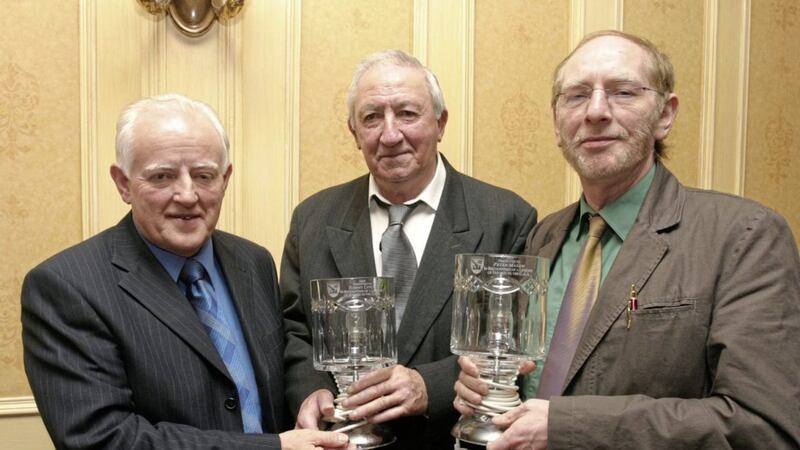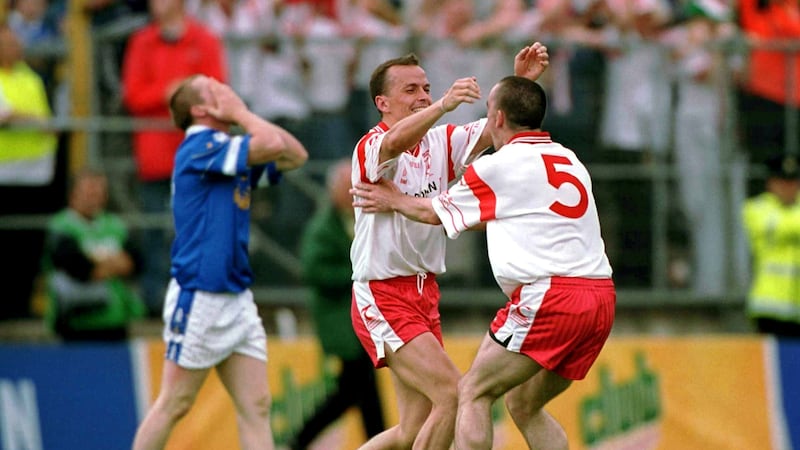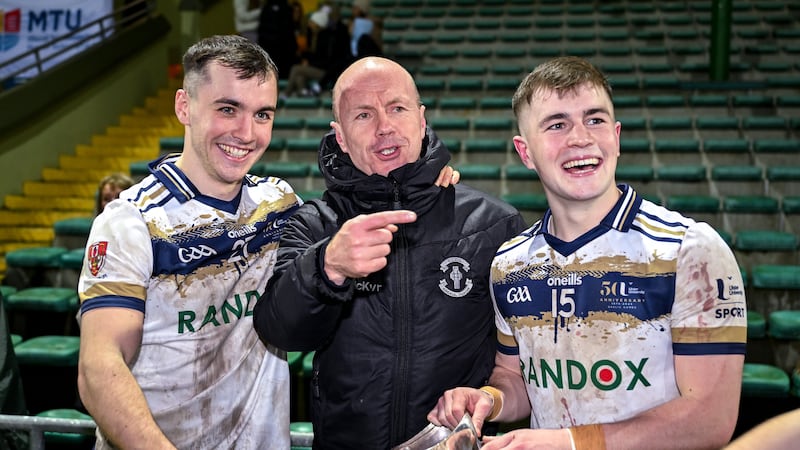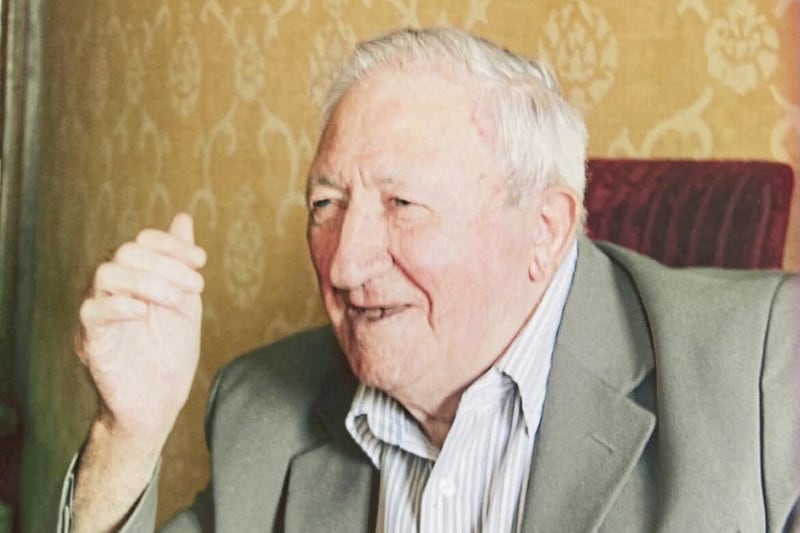Back in 1948 at the age of 16 Tommy Lynch was selected as Corrinshego club delegate to the South Armagh convention. A native of the small rural club west of Newry, he was largely brought into the GAA arena by a neighbouring farmer Eugene Clarke, club founder and driving force, one of those inspirational figures from the era for whom the GAA was a mission in life, a cultural responsibility. They were the times of a natural piece of a level field for playing on, rough goal posts and a ploughed furrow for a sideline, open air changing facilities along a hedge and the prize possession of a football- all the more treasured if it were top of the range pig-skin.
Eugene, who had given one of his fields to the club for playing on, had the first Ferguson tractor in the locality and young Lynch often sat behind him up and down the drills discussing football matters and often drove the tractor himself. But one day a loud voice called from the adjacent road telling him to get off. He turned out to be Harry Ferguson, creator of the famous tractor who was in the area visiting his aunt Mrs Gamble.
So the man who would later become one of Armagh's all time GAA greats was growing into his trade from an early age, a first rate apprenticeship regarding the ideals and ambitions of the association, its book of rules and its personalities.
Naturally intelligent and articulate, Tommy made an impression from this very early age. Even then, if he felt the occasion demanded, he could be as blunt as he was sharp, but his considerable wit and charisma presented an overall natural leader and persuader.
When Corrinshego folded in 1951 because of emigration, Tommy and his brother Paddy went to play for nearby Carrickcruppen and he quickly established himself there in a leading role in fundraising, running dances and carnivals and staging plays to help build up the running costs of his new club. Three years after arriving he was elected a club delegate to the Armagh County Board and the South Board and was getting to know the senior Armagh GAA personalities such as Alf Murray, PJ O Neill, Fr W Mc Knight and Patrick Joe Murray and Peter Murray.
His gifts as a speaker and enthusiasm for "all things Gaelic" including the recently introduced Ciste Gael were acknowledged when he became the second person to be elected chairman of the newly founded All County league and then in 1972 he succeeded Joe French as Chairman of the Armagh County Board.
It was in this position that saw his greatest challenge and greatest triumph. He had a phrase at the time that the county team was the 'shop window'- and his ambition was to create something to sparkle there, but while Down had three Sam Maguire cups and an array of National Leagues and Ulsters, while Tyrone and Derry and Donegal were winning silver, Armagh's window had been boarded up for more than 10 years.
Tommy had been an Armagh senior team selector for several years from the late Sixties and could see the problem that had grown from 1961, the last time the team were in an Ulster Final. He recalled when one of Armagh's finest forwards Jimmy Whan was in charge and was driving all the way from Dublin to training. On one occasion only five players turned up at Lurgan. He got into his car and drove home and never returned.
The same scenario had earlier forced people like Paddy O Hara and Peter Mc Gleenan to resign and later Gerry O Neill in 1972 in his first stint as manager. When Gene Larkin was appointed it was the same story and almost inevitable that there would be a final crash and disintegration- which occurred in Leitrim in November of 1973.
Tommy Lynch was faced with an unprecedented problem. The county team had barely scraped together 15 players at Carrick on Shannon in a national league football match, and were humiliated. The manager resigned at the final whistle and before night the entire Armagh County Board had resigned. Even the Kilkenny football team had moved above Armagh in the rankings. Things had never been so low.
Lynch had two options, either to withdraw Armagh from county football altogether, or call a crisis meeting of club delegates. He settled for the latter. Everybody spoke but nobody had much to say except make exhortations to pull together. However he persuaded the county board members to take up their positions again but while things limped on into 1974 with the county board in charge of the team, a fresh idea was taking shape in his head. It became clear to him from his experience as a team selector that the problem was in getting players to come to train, and so he would focus on that factor and so organised a small group to and gather a proper panel and implement a sense of challenge and vision. He put an immense amount of work into this and was relentless in his drive to restore pride in the Armagh jersey and by 1975 had things on the turn.
Two years later the breakthrough came with an All Ireland final appearance. Tommy had led Armagh out of its darkest hour into one of its brightest, led the setting up of a new system which has lasted to this day, and silverware began to fill the shop window.
"I am a builder by trade. When you get a group of men to do a particular job you must let them know exactly what you want and what the job entails. There has to be a clear endgame, a clear focus. I think I brought something of that to the problems of Armagh football back then."
Involvement was total at both local and national level. He recalled that he was present at 19 annual GAA Congress occasions as an Armagh representative, and spoke his mind on various issues, getting to know the personalities from the other counties.
But as life went on, he greatly widened the scope of what he inherited from Eugene Clarke to convert the wider elements of the great Irish cultural renaissance of the latter quarter of the 19th century, not merely the founding of the GAA in 1884 but to reflect the other elements such as the Gaelic League, the collections of Irish music, the gathering of the legends and mythology of Ireland, a national theatre, and the rise of great literature.
Tommy was the founder and major organiser of the GAA-backed Scor in Armagh and Ulster in the early Eighties, and was Armagh chairman for 15 years, firmly helping to establishing it as a core cultural dynamic and major success story. He also wrote a sketch for the club "Where do you think you live"? that won the Armagh Scor and reached the Ulster final in 2018. It involved four famous local personalities, Finn, Cuchullain, Dr Patrick Donnelly, aka Phelim Brady, the Bard of Armagh, and Redmond O Hanlon the raparee.
A man of culture he married into culture as his wife Mary is the daughter of Harry Davidson from Ballymoyer, the well known traditional singer, accordion player and founder of the Harry Davidson Ceili band.
Tommy and Mary's daughters followed the tradition of their parents and were All –Ireland Scor champions in music and dancing and have represented Ireland in athletics in Europe.
In 1998, he founded the local Camlough Heritage committee and served as chairman with a view to commemorating the original names of the local townlands with special plaques, thirty in all, and warmed to the task of undoing the verbal mask of Anglicisation that had hidden the original meanings for two centuries. He understood that these names came naturally from the shapes and eccentricities of the landscape largely moulded in the last ice age, and which more or less called out their names rather than anyone imposing them.
Several years ago he created a special visual history of the Carrickcruppen club and delivered it in the local hall detailing all the personalities and hard slog involved in setting up such an enterprise, leading eventually to the times of success.
Every year without fail until the current outbreak of the coronavirus he embarked on his pilgrimage to the two drama festivals in the district, Newry and Lislea, a familiar figure in the back row.
More and more he became fascinated with all cultures, how the different peoples of the world responded to life through their games and customs, through their music and song and he saw this as a natural flowering of particular roots. But at the end of the day, everybody was articulating the same fundamental things of life, the same deep hopes and fears, the same deep aspirations and a particular culture was the living out of these aspirations in a specific manner. Community Relations was no longer a celebration of difference, but a celebration of what deeply unites.
As he reflected on his long and active life, now 88 and as mentally alive and eloquent as ever, he felt, like his teacher of old Eugene Clarke, that he had a mission to open up a great natural cultural inheritance of the people where they could most authentically express themselves.
In the scope of his contribution to the GAA and to the wider cultural arena, he has bequeathed a superb legacy to his native county and beyond and belongs profoundly to that great cultural renaissance mentioned above that opened up Ireland into its own immense natural riches.




